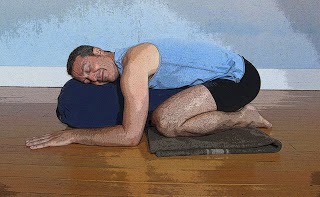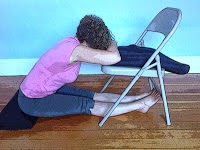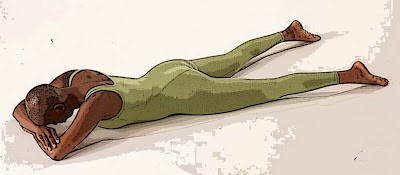We recently received this comment on Ram’s post about trauma (see Post-Traumatic Stress Disorder: Yoga to the Rescue).
Q: This is a very important topic. I have always been pretty surprised that my yoga teachers (many of whom are simply excellent) seem oblivious to the trauma students bring into their studios. I was mistreated as a child and when I began a yoga practice, I was unprepared for how yoga resurfaced issues that I had long thought were put to rest. But there I was — breaking out into tears in bridge pose in the middle of class for no apparent reason. I could not find anything (or anyone, though I was not exactly willing to shout my needs from the mountaintop) that could help me understand what was happening. My teacher at the time was sympathetic, but stumped. I have since learned from friends who were sexually assaulted that yoga kicked issues up for them, too. It took me a while to understand somatic memory and to find ways to use yoga as a source of healing. I wish I could have found some help with that since I was so new to yoga and did not really have a sense of how to proceed. Is there any effort to make this part of most training programs? Are there guides or reading materials for us to learn from? Often, when I go into a new class, I count the students and do a rough estimate of the survivors of child abuse and sexual assault (knowing the stats and assuming a random sample of the US population is present). The number is never zero.
A: I’m so sorry to hear about the difficulties that you, our commenter, have experienced, both in terms of the original abuse and then later having the experiences resurface in your yoga class. And I’m very glad your teacher was sympathetic and that—eventually—you found ways to use yoga as a source of healing. But one thing for you to realize is that it is quite common for yoga students to cry during class (especially during backbends) for any number of reasons. So while you suspected that you were crying due to traumas resurfacing during practice, a yoga teacher could not possibly know that from your tears alone (see Baxter’s comments below about crying during class). And unless you are studying with a yoga teacher who is also a trained therapist or has taken a special training program to work with students recovering from trauma, it is actually not appropriate for an ordinary yoga teacher to try to help you with these issues.
In my training, in fact, I was specifically instructed not to try to comfort or take care of a crying student. This may sound harsh but the reasoning is that, first, you can’t know why the student is crying and, second, you do not have the training to be counseling a student about emotional issues because you are not a therapist. (This is equivalent to the yoga teacher’s situation with students who have physical problems. Because we are not doctors, we should not be diagnosing and treating medical conditions in our students, but should refer them to experts for help.) At most, we were told, we could offer a more comforting yoga pose to do.
For example, once while I was assisting Rodney Yee in a backbend workshop (backbends are known for triggering tears) a student began to cry. He told me to quietly offer the student a bolster and ask her whether she wanted to set up in Supported Child’s pose, which she did. And that seemed to help calm her. So, in general, as a teacher who is not specially trained to help students who have survived trauma or abuse, I’d say that if you start crying in a yoga pose and you feel comfortable enough to continue on, you could just allow yourself to cry. But if you do not want to continue in the pose, you should come out and take a pose that feels more comfortable to you, possibly a pose where your front body is protected (the opposite of a backbend) whether that is Supported Child’s pose, a Supported Forward Bend, or even Crocodile Pose (Makrasana) where you lie on the floor on your belly. If these types of poses don’t offer comfort, perhaps try a simple seated pose or any other pose your intuition tells you will work for—whatever feels best. And if you were to come to me after class and share with me the reason for your crying, I would recommend that you see a therapist or an expert on trauma for advice.
 |
| Supported Child’s Pose |
 |
| A Supported Forward Bend |
 |
| Crocodile Pose |
Because none of our staff members here at Yoga for Healthy Aging have expertise in that area, we won’t be responding to your comment with specific advice about the issues you raised. However, fortunately for all of us, there are some therapists and experts who do use yoga and meditation to help patients who are survivors of sexual abuse and other forms of trauma. One that was recommended to me by a reliable source (thank you, Jarvis Chen!) is Bessel van der Kolk, MD, founder of the Trauma Center at the Justice Resource Institute in Brookline, MA. Here is an interview with him www.traumacenter.org.
This quote from that interview is particularly relevant for us:
“Yoga teachers need to be aware that material will come up during class and they need to be prepared at all times to help people to calm down their bodies, by working with the breath and quieting poses. Teachers should create a safe space in the class, keep the focus on the breath and the flow of the asanas. It is best to refrain from excessive talking, explaining or preaching during the class—the job of the Yoga teacher is to help people to feel safe in every aspect of their self-experience.”
Some of van der Kolk’s associates have actually written a book on the topic Overcoming Trauma Through Yoga by David Emerson and Elizabeth Hopper, PhD. And David Emerson, director of yoga services at the Trauma Center, has a forthcoming book called Trauma-Sensitive Yoga in Therapy (see www.traumasensitiveyoga.com).
I noticed that Emerson will be teaching a workshop on this topic in October 2014 at Kripalu (see http://kripalu.org/program/view/TSYT-142) and that the Trauma Center provides Trauma-Sensitive Yoga Teacher Training (contact demerson@traumacenter.org).
So that’s a few resources to get you—and anyone else who is concerned about this issue—started.
Now here’s something more from Baxter about how a yoga teacher should handle the general situation of a student crying in class.
—Nina
A: I clearly remember, during my teacher training days, the first time one of my fellow students began to cry in class. I mean, really cry loudly. I was simultaneously confused (was she in pain?) and worried about her (should I console her?). Her crying began during a restorative pose—something like Child’s pose—and it ultimately lasted a minute or two. The teacher did not directly address the crying, which was also quite curious. After class, the student shared with some of us that she was actively processing some long-standing grief and that we might expect more of such crying in the future. She had discussed it with the teacher previously, and so they had an understanding of what was happening. These crying episodes went on intermittently for months afterwards.
I also recall the first time I experienced tears during practice, also while doing Child’s pose (Balasana) in my home practice. I don’t recall the thought or feeling that preceded the tears rolling, but they sure came out. There was some sadness associated with the act of crying, but also a kind of liberation of emotion that felt quite good.
In my classes, I will occasionally notice someone crying, usually during the cool down period of class or in Savasana. But I have also seen this happen at the start of class during sitting meditation, too. If the tears are quiet, I usually observe as unobtrusively as I can, what is happening, and rarely feel the need to directly check in with the student. These are almost always regular students of mine, so I have experience working with them already and feel pretty confident that they will check in with me later if necessary. But, like Nina, I tend to focus on maintaining the practice space for all of the students and not intruding on the crying episode.
On rare occasion, if there is louder crying, as quietly as I can, I will approach the student and ask if they need anything from me. I try not to pacify or console, or imply that I know what they are going through, but continue to cultivate a safe environment for them to experience their full practice. In fact, there is no way for me to know exactly what the student is experiencing in that moment, and in some ways, it is not really my business.
As yoga teachers, we are not trained to address the emotional health of our students, as psychologists are. If a student were to approach me with questions about how to deal with difficult emotions, I would refer them to a trained therapist who can appropriately work with them. At the same time, I also can acknowledge to myself that their ongoing yoga practice may help support any work they may choose to do around emotional well-being. But ultimately, it is important to know and acknowledge the limits of my expertise as a yoga instructor and to convey that in a kind and clear way.
—Baxter
Follow Yoga for Healthy Aging on Facebook ° To order Yoga for Healthy Aging: A Guide to Lifelong Well-Being, go to Amazon, Shambhala, Indie Bound or your local bookstore.


Thank you for this post; I think lots of teachers will benefit as I've seen little written about it. This line of Baxter's really resonated with how I feel on the topic: "I try not to pacify or console, or imply that I know what they are going through, but continue to cultivate a safe environment for them to experience their full practice." Creating a safe space for the more intense moments of the practice to be digested is key, and I believe is often what enables them to come up for people in class in the first place. I find it useful to let students know that when practicing yoga over a series of years almost every emotion available will be experienced to some degree and that crying from sadness or any other emotion can be a healthy and useful way to process those emotions or experiences that arise. I wonder if saying even that much goes outside scope of practice, but nonetheless it's been beneficial for students who have cried in class to hear and understand so they don't feel there is something wrong with their practice or something that needs fixing.
Nina, thank you for the resources for better supporting those working with a history of trauma. The front body protected poses are excellent reminders.
Thank you for this important post. I think we will be seeing much more about the benefits of a yoga practice for trauma survivors. I can highly recommend the book by Emerson and Hopper, and the training through the Trauma Center at JRI. As an adjunct to talk therapy, I believe yoga is a powerful ally in the treatment of trauma, and hope that more people will become aware of its benefits. In those cases, making sure that the student is already actively in therapy is vital, so that what comes up in yoga class can be processed safely with a trusted professional. In my experience so far, your advice about child's pose (and front body protecting positions) is spot on – although, naturally any pose could trigger emotions and memories, as each individual's experience is unique. As the original commenter stated, I agree that there are likely many more trauma survivors in our classes than we realize, and although there is no way of knowing the reason for the spontaneous tears in class, I think it's a gift for any practitioner to be in an environment where experiencing and expressing emotions is welcomed and not judged – something that all yoga teachers can strive to provide.
Not exactly on topic, but here goes. I'm not a teacher, but a regular student at classes. I can think of 2 occasions on which the *yoga teacher* was visibly in emotional distress due to circumstances that didn't have anything to do with the class. In 1 of these cases, the teacher mentioned what happened (just a few words), and apologized for so mentioning. In the other case, the teacher (a different one) didn't explain at all. As a student, I respect both ways that the teachers conducted themselves. Furthermore, if the 1st teacher had omitted the apology, that would have been ok also. It helped that in both cases, I was confident that the distress was of a survivable sort. – BTW, I occasionally have a few subtle quiet tears. Yoga class is one of the few places where that is apt to happen. Classes almost always end with Corpse Pose, and consciousness of the fact of death is (for many of us) a part of our spiritual paths. – One other thought. I am often reminded how common suffering is in our world. Sometimes I can help, usually I can't. It's not simply a matter of "expertise", but a matter of respecting limitations of all kinds. Limitations are partly a matter of expertise, but also matters of time and emotional energy and whether the sufferer might or might not benefit from intervention. And that's before we even get to things like legal liability. – I like the idea of supported Child's Pose.